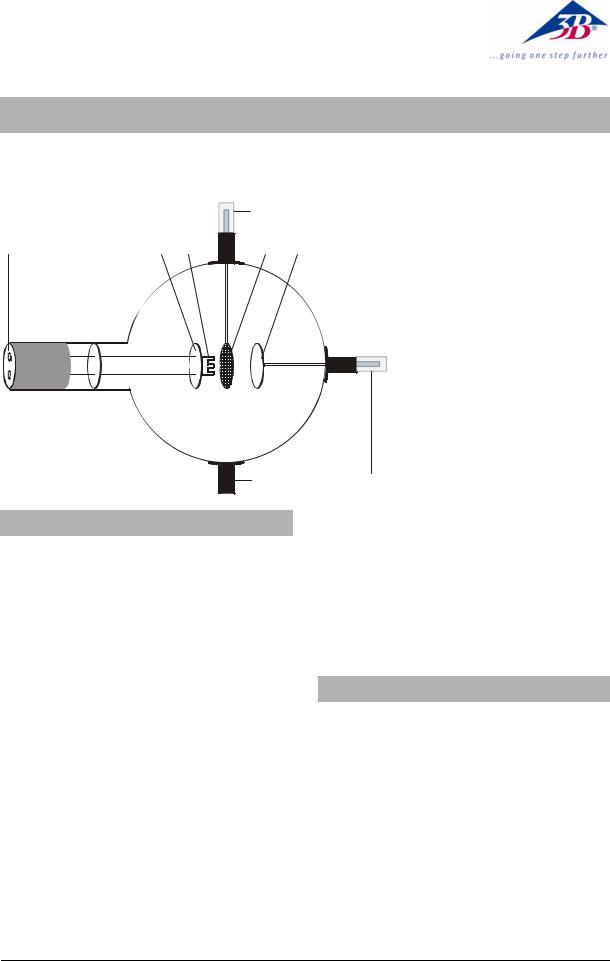3B Scientific Teltron Triode D Helium-filled User Manual

3B SCIENTIFIC® PHYSICS
Gas Triode D 1000653
Instruction sheet
12/12 ALF
5
8 |
7 |
6 |
4 |
3 |
-
1
1. Safety instructions
Hot cathode tubes are thin-walled, highly evacuated glass tubes. Treat them carefully as there is a risk of implosion.
•Do not subject the tube to mechanical stresses.
•Do not subject the connection leads to any tension.
•The tube may only be used with tube holder D (1008507).
If voltage or current is too high or the cathode is at the wrong temperature, it can lead to the tube becoming destroyed.
•Do not exceed the stated operating parameters.
When the tube is in operation, the terminals of the tube may be at high voltages with which it is dangerous to come into contact.
•Only change circuits with power supply equipment switched off.
•Only exchange tubes with power supply equipment switched off.
When the tube is in operation, the stock of the tube may get hot.
1Boss
24-mm plug for connecting anode
3Anode
4Grid
5Boss with 4-mm plug for connecting grid
6Heater filament
7Cathode plate
84-mm sockets for heater filament and cathode
2
•Allow the tube to cool before dismantling.
Use of the equipment over long periods and involving hefty gas discharges can cause loss of material from the electrodes, which is deposited on the glass of the tube itself resulting in darkening of the surface.
The compliance with the EC directive on electromagnetic compatibility is only guaranteed when using the recommended power supplies.
2. Description
The gas triode allows recording of the IA – UA characteristic of a thyratron, observation of excited and non-excited discharge and of the discontinuous transfer of energy by helium atoms in inelastic collision with free electrons.
The gas triode is a helium-filled tube with a pure tungsten heater filament (cathode) and a round metal plate (anode) with a wire grid between them, all inside a clear glass bulb. The cathode, anode and grid are all aligned parallel to one another. This planar configuration corresponds to the conventional symbol for a triode. A circular metal plate attached as a backing to the filament ensures that the electric field between the anode and cathode is uniform.
1

3. Technical data
Gas filling: |
Helium |
Filament voltage: |
≤ 7.5 V AC/DC |
Anode voltage: |
max. 500 V DC max. |
Anode current: |
10 mA typ. at Ua = 300 V |
Grid voltage: |
max. 30 V |
Glass bulb: |
130 mm diam. approx |
Length of tube: |
260 mm approx. |
4. Operation
To perform experiments using the gas triode the
following equipment is also required: |
|
1 Tube holder D |
1008507 |
1 DC Power supply 500 V (@115 V) |
1003307 |
or |
|
1 DC Power supply 500 V (@230 V) |
1003308 |
2 Analogue multimeter AM50 |
1003073 |
Additionally recommended: |
|
Protective Adapter, 2-Pole |
1009961 |
4.1 Setting up the tube in the tube holder
•The tube should not be mounted or removed unless all power supplies are disconnected.
•Push the jaw clamp sliders on the stanchion of the tube holder right back so that the jaws open.
•Push the bosses of the tube into the jaws.
•Push the jaw clamps forward on the stanchions to secure the tube within the jaws.
•If necessary plug the protective adapter onto the connector sockets for the tube.
4.2 Removing the tube from the tube holder
•To remove the tube, push the jaw clamps right back again and take the tube out of the jaws.
5.Example experiments
5.1Discharge, evidence of positive charge carriers
•Set up the circuit as in fig. 1.
•To demonstrate the existence of positive charge carriers (He+ ions) for gas discharge
at a maximum heater filament voltage UF, measure the current IG taking note of the sign.
5.2 Non-self-sustaining discharge
•Set up the circuit as in fig. 2.
•Record a characteristic curve of IA against UA (= UG) for various filament voltages UF (5 V …7.5 V).
At about 25 V the anode current IA increases considerably in the gas triode. This increase is accompanied by the appearance of a blue luminescence. It is apparent that there are many more charge carriers transporting charge than in the vacuum triode (since there are He+ ions as well as thermal electrons).
5.3 Self-sustaining discharge
•Set up the circuit as in fig. 3.
•Gradually increase the anode voltage UA and determine the striking voltage US for the gas discharge.
•Reduce the anode voltage UA again until the self-sustaining discharge ceases. Record this extinguishing voltage UE.
5.4 Simplified Franck-Hertz-set-up
Experiment for demonstrating discontinuous energy emission resulting from inelastic collisions between between electrons and helium atoms. The electrons have to travel through a decelerating reverse-potential field between the grid and anode, so that they only arrive at the anode if they possess sufficient kinetic energy. Only then do they contribute to the current IA between anode and ground.
•Set up the circuit as in fig. 4.
•For a reverse polarity UR of 6 V, gradually raise the accelerating potential UA from 0 V to 70 V and measure the anode current IA.
•Plot a graph of the anode current as a function of the accelerating voltage.
Up to an accelerating potential of about 24 V, the anode current increases but then it drops suddenly. As the accelerating potential is further increased the current increases once again but after another 20 V or so it drops again.
A plot of the anode current should exhibit two clear maxima. If this is not perceptible, the filament voltage should be lowered somewhat.
2
